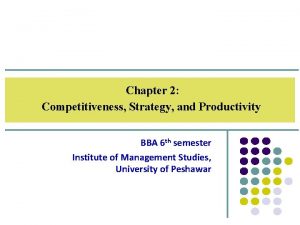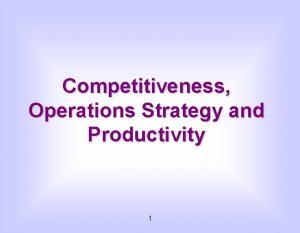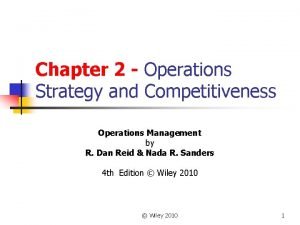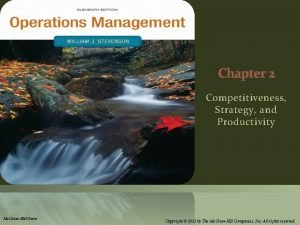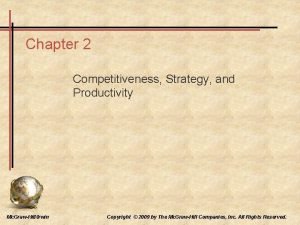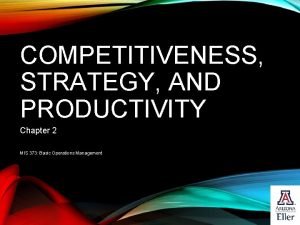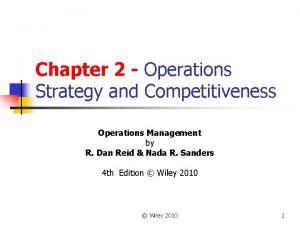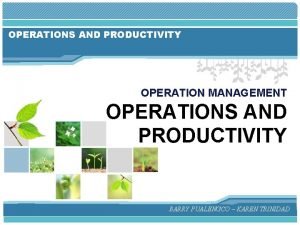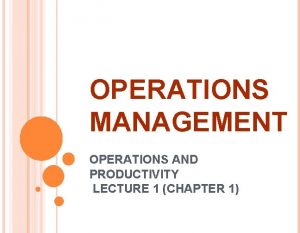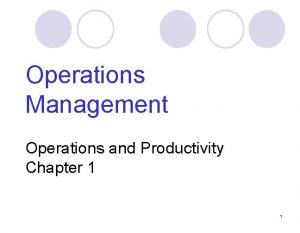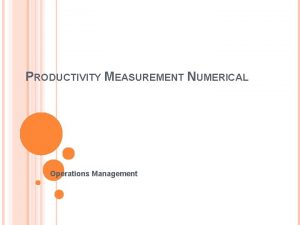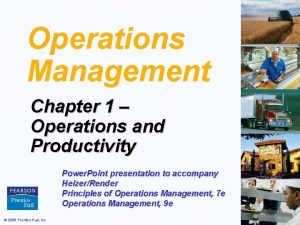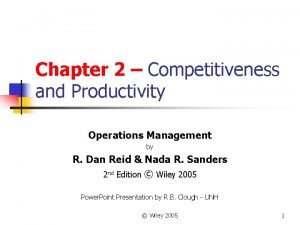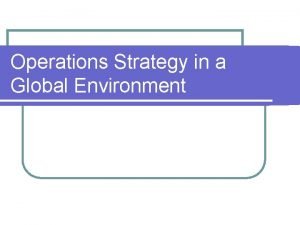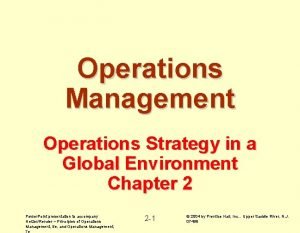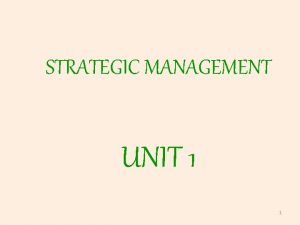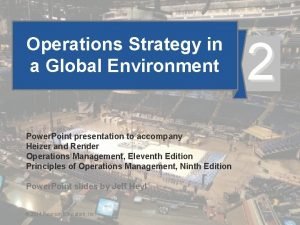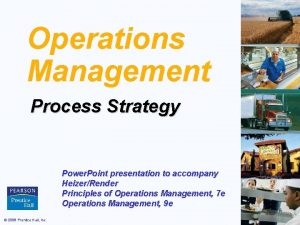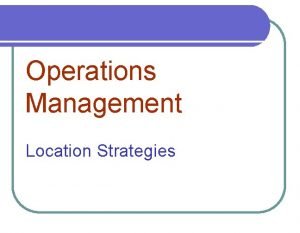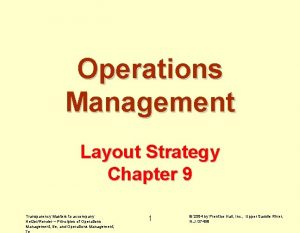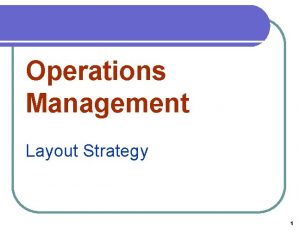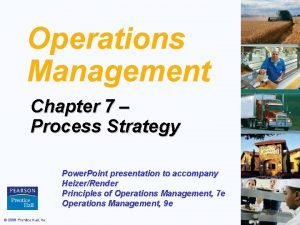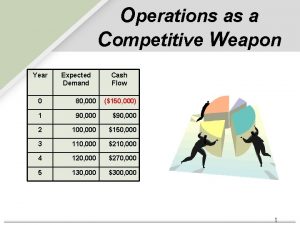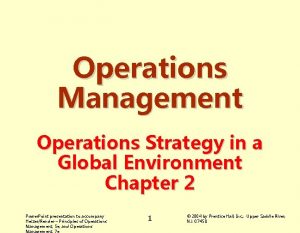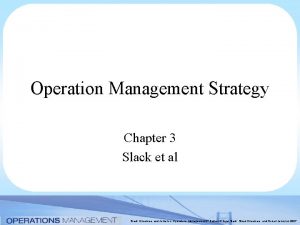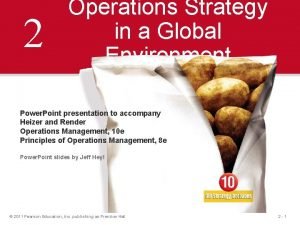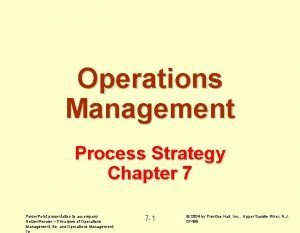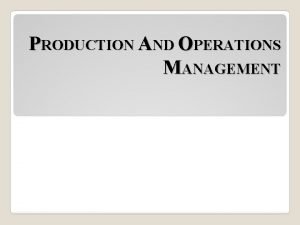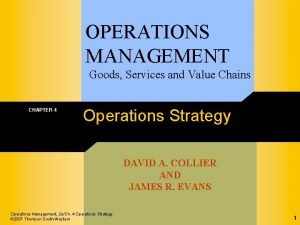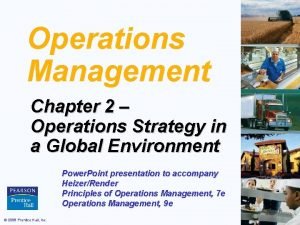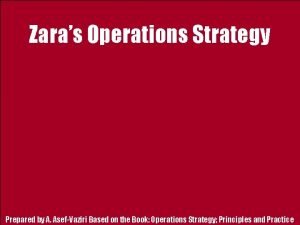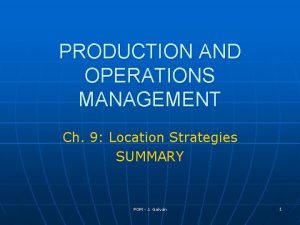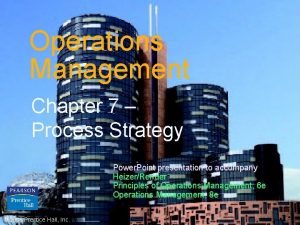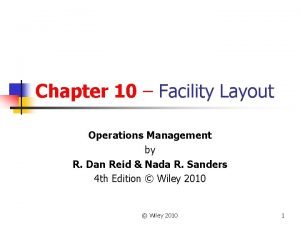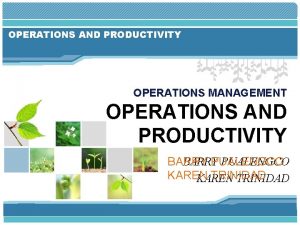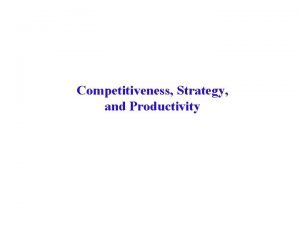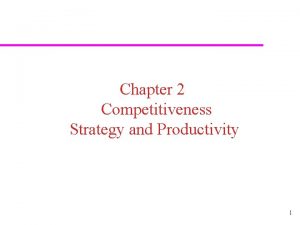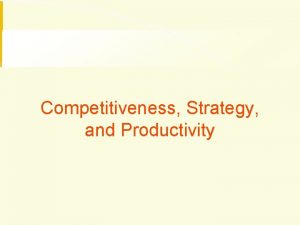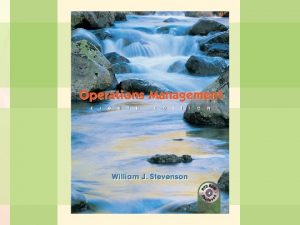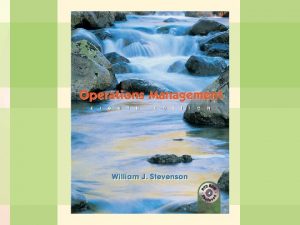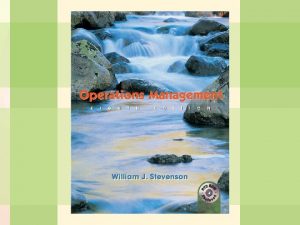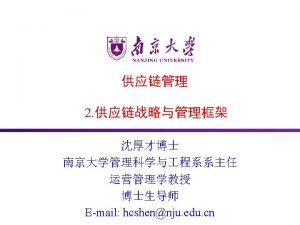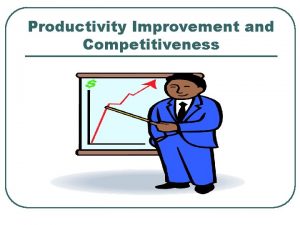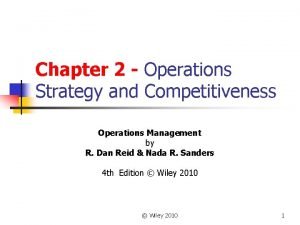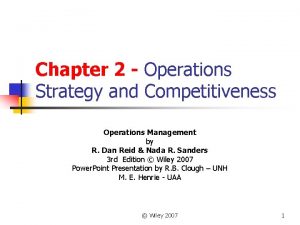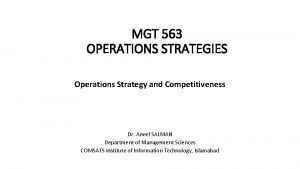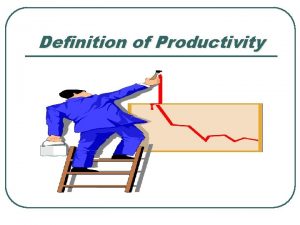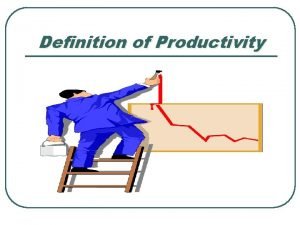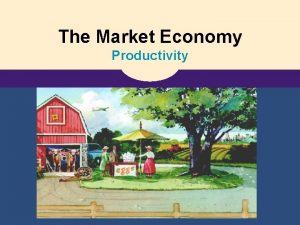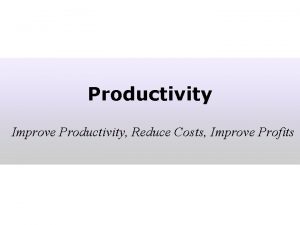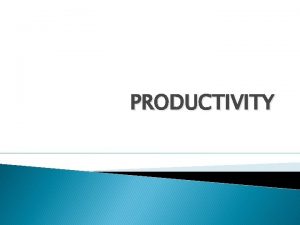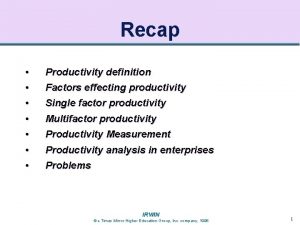Competitiveness Operations Strategy and Productivity 1 Competitiveness The




























































- Slides: 60

Competitiveness, Operations Strategy and Productivity 1

Competitiveness: The extent that an organization meets the wants and needs of customers relative to others that offer similar goods or services 2

Marketing Influences Competitiveness by: ØIdentifiying consumer needs and desires ØPricing ØAdvertisement and promotion 3

Operations Influences Competitiveness Through (1 of 4): 1. Product and Service Design 2. Cost 3. Location 4. Quality and Reliability 4

Operations Influence Competitiveness Through (2 of 4): 5. Quick or Reliable Response a. New Product Introduction Speed b. Delivery Speed c. Delivery Reliability 6. Service 5

Operations Influences Competitiveness Through (3 of 4): 7. Flexibility a. in making alterations in design b. in coping with changes in volume c. in new product introduction 8. Inventory Management 6

Operations Influences Competitiveness Through (4 of 4): 9. Supply Chain Management 10. Service and Service Quality 11. Managers and Workers 7

Competing on Cost Ø Eliminate all waste Ø Invest in Ø Updated facilities & equipment Ø Streamlining operations Ø Training & development 8

Competing on Quality ü Please the customer ü Understand customer attitudes toward and expectations of quality 9

Competing on Flexibility ü Produce wide variety of products ü Introduce new products ü Modify existing products quickly ü Respond to customer needs 10

Competing on Speed ü Fast moves ü Fast adaptations ü Tight linkages 11

Why Some Organizations Fail? (1 of 2) Ø Too much emphasis on short-term financial performance Ø Failing to take advantage of strengths and opportunities Ø Failing to recognize competitive threats Ø Neglecting operations strategy 12

Why Some Organizations Fail? (2 of 2) Ø Too much emphasis in product and service design and not enough on improvement Ø Neglecting investments in capital and human resources Ø Failing to establish good internal communications Ø Failing to consider customer wants and 13 needs

Mission Ø Mission - where you are going? Ø The reason for existence for an organization Ø Provides boundaries & focus 14 © 1995 Corel Corp.

Mission of the Hard Rock Café To spread the spirit of Rock ‘n’ Roll by delivering an exceptional entertainment and dining experience. We are committed to being an important, contributing member of our community and offering the Hard Rock family a fun, healthy, and nurturing work environment while 15 ensuring our long-term success.

Mission/Strategy ØMission - where you are going ØStrategy - how you are going to get there; an action plan 16

Strategy Ø Action plan to achieve mission (shows how mission will be achieved) Ø The company has a business strategy Ø Functional areas 17 © 1995 Corel Corp.

Mission/Goal/Strategy/Tacti cs ¨ Mission: the reason for existence for an organization ¨ Goals: Provide detail and scope of mission ¨ Strategies: Plans for achieving organizational goals ¨ Tactics: Actions taken to accomplish strategies. Answers the question: “How to reach the destination, following the strategy road map? ” 18 © 1995 Corel Corp.

Planning and Decision Making Mission Goals Organizational Strategies Functional Goals Finance Strategies Tactics Operating procedures Marketing Strategies Tactics Operating 19 procedures Operations Strategies Tactics Operating procedures

Strategy Example Rita is a high school student. She would like to have a career in business, have a good job, and earn enough income to live comfortably ØMission: Live a good life ØGoal: Successful career, good income ØStrategy: Obtain a college education 20 ØTactics: Select a college and a

Examples of Strategies Ø Low cost Ø Scale-based strategies Ø Specialization Ø Flexible operations Ø High quality Ø Service Ø Rapid response 21

Quality and Time Strategies Ø Quality-based strategies ØFocuses on maintaining or improving the quality of an organization’s products or services ØQuality at the source 22 Ø Time-based strategies

Examples of Operations Strategies Price Low Cost U. S. first-class postage Motel-6, Red Roof Inns Quality High-performance design or high quality Consistent quality Sony TV Lexus, Cadillac Pepsi, Kodak, Motorola Time Rapid delivery On-time delivery Express Mail, Fedex, One-hour photo, UPS Flexibility Variety Volume Burger King Supermarkets Service Superior customer service Disneyland Nordstroms Location Convenience Banks, ATMs 23

Strategy Formulation 1. Defining a primary task 2. Identification of distinctive competencies 3. Scanning the environment and make SWOT analysis 4. Identification of order winners & order qualifiers 5. Positioning the firm 24

Strategy Formulation Step 1: Defining A Primary Task Define what the firm is in the business of doing. Define the competitive arena 25

Identification of Distinctive Competencies · The special attributes or abilities possessed by the organization that give it a competitive edge. What the firm does better than anyone else (critical success factors, core competencies) Develop Distinctive Competencies based on customer needs and on what the competitors doing 26

Strategy Formulation Step 3: Environmental Scanning & SWOT Analysis The consideration of events and trends that present threats or opportunities for a company 27

Environmental Scanning: Key External Factors ØEconomic conditions ØPolitical conditions ØLegal environment ØTechnology ØCompetition ØCustomers and Markets ØSuppliers 28 ØDistributors

Environmental Scanning: Key Internal Factors ØResources available (human resources, facilities and equipment, financial resources) ØExisting and potential products and services ØTechnology ØStages of life cycles of current products 29

SWOT Analysis to Strategy Formulation Mission Internal Strengths External Opportunities Strategy Internal Weaknesses Competitive Advantage 30 External Threats

Strategy Formulation Step 4: Identification of Order Qualifiers and Order Winners 31

Order Qualifiers : Defined Order qualifiers are the basic criteria that permit the firm’s products to be considered as candidates for purchase by customers. These are the characteristics that customers perceive as minimum standards of acceptability to be considered as a potential purchase. 32

Order Winners: Defined Order winners are the criteria that differentiate the products and services of the firm from others’. These are the characteristics that cause the product to be perceived as better than competitors’ products 33

¨ A brand name car can be an “order qualifier” Repair services can be “order winners” Examples: Warranty, Roadside Assistance, Leases, etc 34

Strategy Formulation Step 5: Positioning the Firm ØThe firm’s positioning strategy defines how it will compete in the marketplace, ie. what unique value it will deliver to the customer. ØChoosing one or two important things on which to concentrate and doing them extremely well. 35

Organization Strategy/Operations Strategy ØThe organization strategy provides the overall direction for the organization. It is broad in scope covering the entire organization ØOperations strategy is the approach consistent with organization strategy that is used to guide the operations function. It is narrower in scope, dealing with the operations aspect 36 of the organization.

Organizati Relates to on Strategy growth rate, market share Operations Relates to Strategy product design; choice of location, technology, new facilities 37

Operations Role in Corporate Strategy ü Provide support for overall strategy of a firm ü Serve as firm’s distinctive competence ü Must be consistent with overall strategy 38

Strategic Planning Mission and Vision Voice of the Business Marketing Strategy Corporate Strategy Operations Strategy 39 Voice of the Customer Financial Strategy

Impetus for Strategy Change ØChanges in the organization ØStages inthe product life cycle ØChanges in the environment 40

Global Strategy Ø Strategic decisions must be made with respect to globalization Ø What works in one country may not work in another Ø Strategies must be changed to account for these differences Ø Other issues Ø Political, social, cultural, and 41 economic differences

Strategic Decisions in Operations Products Services Processes, Technology Job design Quality Capacity Facilities Sourcing 42 Operating Systems

Some Strategic OM Decisions and their effects Decision Area Affects Product and service design Costs, quality liability and environmental Capacity Cost structure, flexibility Process selection and layout Costs, flexibility, skill level, capacity Work design Quality of work life, employee safety, productivity Location Costs, visibility Quality Ability to meet or exceed customer expectations 43

Productivity 44

What is Productivity? Productivity is a common measure of how well resources are being used. Output Productivity = Input 45

Typical Impacts of Productivity Improvement As productivity improved Wages increased Parts per man hour Costs were decreased Cost per unit decreased $2. 25 110 Average worker's annual cash compensation increased 27000 $2. 00 105 26000 $1. 75 100 95 25000 24000 $1. 50 Year A Year B Year C Year A 46 Year B Year C Year A Year B Year C

Measures of Productivity (1 of 2) Ø Partial measures Ø output/(single input) Ø Multi-factor measures Ø output/(multiple inputs) Ø Total measure Ø output/(total inputs) 47

Measures of Productivity (2 of 2) Partial measures Output Labor Output Machine Capital Output Energy Multifactor Output measures Labor + Machine Labor + Capital + Energy Total measure Goods or Services Produced All inputs used to produce them 48

Examples of Partial Productivity Measures Labor Productivity Units of output per labor hour Units of output per shift Value-added per labor hour Machine Productivity Units of output per machine hour Value-added per machine hour Capital Productivity Units of output per dollar input Dollar value of output per dollar input Energy Productivity Units of output per kilowatt-hour Dollar value of output per kilowatt-hour 49

Typical Measures of Productivity Restaurant Customers (meals) per labor hour Retail store Sales per square foot Chicken farm Lbs of meat per lb. of feed Utility plant Paper mill Kilowatts per ton of coal Tons of paper cord 50 of wood

Measurement Problems Ø Quality differences may distort productivity measurements Ø External elements may cause an increase or decrease in productivity Ø Precise units of measure may be lacking Ø Technological differences may lead to misleading results. 51

Productivity Growth = ent Period Productivity – Previous Period Productivity Growth is a key factor in a contry’s rate of inflation and the standard of living of its people 52

Process Yield Ø Process yield is the ratio of output of good product to input Ø Defective product is not included in the output Ø Service example: Ø Ratio of cars rented to cars 53 available to rent

Productivity improves when firms: Ø Become more efficient Ø Downsize Ø Expand Ø Retrench Ø Achieve breakthroughs 54

Factors Affecting Productivity (1 of 3) Ø Standardization Ø Quality Ø Technology Ø Use of Internet, fax machines, e-mail, computerized billing, software Ø Searching for lost or misplaced items Ø Scrap rates Ø Labor turnover, layoffs, new workers Ø Safety 55 Ø Bottlenecks

Factors Affecting Productivity (2 of 3) ØMethods ØDesign of the workspace ØIncentive plans that reward productivity ØCapacity utilization ØLocation ØLayout ØInventory ØScheduling 56

Factors Affecting Productivity (3 of 3) ØShortage of IT workers and other technical workers ØEquipment breakdowns ØPart and material shortages ØInadequate investment in training & education of the employees 57

Key Steps for Improving Productivity Ø Develop productivity measures Ø Determine critical (bottleneck) operations Ø Develop methods for productivity improvements Ø Establish reasonable goals Ø Get management support Ø Measure and publicize improvements Ø (Don’t confuse productivity with 58 efficiency)

Service Productivity ØTypically labor-intensive ØFrequently individually processed ØOften an intellectual task is performed by professionals ØOften difficult to mechanize or automate 59

Productivity in the ‘ 90 s – 7– 6– 5– 4– 3– 2– 1– 0– -1 – -2 – -3 – | ‘ 90 United St Germany Japan | ‘ 91 | ‘ 92 | ‘ 93 | | ‘ 94 60 ‘ 95 | ‘ 96 | ‘ 97 | ‘ 98 | ‘ 99 | | ‘ 00 2001
 Competitiveness, strategy, and productivity
Competitiveness, strategy, and productivity Scale based strategy
Scale based strategy Productivity and competitiveness in operations management
Productivity and competitiveness in operations management Competitiveness strategy and productivity
Competitiveness strategy and productivity The methods and actions taken to accomplish strategies
The methods and actions taken to accomplish strategies Competitiveness strategy and productivity
Competitiveness strategy and productivity Operations strategy and competitiveness
Operations strategy and competitiveness Operation management chapter 2
Operation management chapter 2 How do you measure productivity
How do you measure productivity Operations and productivity
Operations and productivity Operations and productivity
Operations and productivity Operation and productivity chapter 1
Operation and productivity chapter 1 Productivity measurement in operations management
Productivity measurement in operations management Productivity definition in operations management
Productivity definition in operations management Multifactor productivity operations management
Multifactor productivity operations management Operation strategy in global environment
Operation strategy in global environment The global environment and operations strategy
The global environment and operations strategy Operations strategy in a global environment
Operations strategy in a global environment Operations strategy in a global environment
Operations strategy in a global environment Strategic management and strategic competitiveness
Strategic management and strategic competitiveness Corporate strategy and business strategy
Corporate strategy and business strategy Chase production plan
Chase production plan Strategy tactics operations
Strategy tactics operations Operations strategy in a global environment
Operations strategy in a global environment Process focus strategy in operations management
Process focus strategy in operations management Service location strategy
Service location strategy What is layout strategy
What is layout strategy Retail layout operations management
Retail layout operations management Four basic process strategies
Four basic process strategies Operations strategy as a competitive weapon
Operations strategy as a competitive weapon Strategic planning for retail business
Strategic planning for retail business Operations strategy in global environment
Operations strategy in global environment Operations strategy slack
Operations strategy slack Chapter 2 operations strategy in a global environment
Chapter 2 operations strategy in a global environment Hamburger chart
Hamburger chart Operations strategy case study
Operations strategy case study Professor hill's strategy development framework
Professor hill's strategy development framework Operations management chapter 2
Operations management chapter 2 Transnational strategy vs global strategy
Transnational strategy vs global strategy Zara operations strategy
Zara operations strategy Location strategy in operations management
Location strategy in operations management Operations management chapter 7 solutions
Operations management chapter 7 solutions Layout strategy in operations management
Layout strategy in operations management Hát kết hợp bộ gõ cơ thể
Hát kết hợp bộ gõ cơ thể Ng-html
Ng-html Bổ thể
Bổ thể Tỉ lệ cơ thể trẻ em
Tỉ lệ cơ thể trẻ em Chó sói
Chó sói Glasgow thang điểm
Glasgow thang điểm Chúa sống lại
Chúa sống lại Các môn thể thao bắt đầu bằng tiếng nhảy
Các môn thể thao bắt đầu bằng tiếng nhảy Thế nào là hệ số cao nhất
Thế nào là hệ số cao nhất Các châu lục và đại dương trên thế giới
Các châu lục và đại dương trên thế giới Cong thức tính động năng
Cong thức tính động năng Trời xanh đây là của chúng ta thể thơ
Trời xanh đây là của chúng ta thể thơ Cách giải mật thư tọa độ
Cách giải mật thư tọa độ Phép trừ bù
Phép trừ bù độ dài liên kết
độ dài liên kết Các châu lục và đại dương trên thế giới
Các châu lục và đại dương trên thế giới Thơ thất ngôn tứ tuyệt đường luật
Thơ thất ngôn tứ tuyệt đường luật Quá trình desamine hóa có thể tạo ra
Quá trình desamine hóa có thể tạo ra
